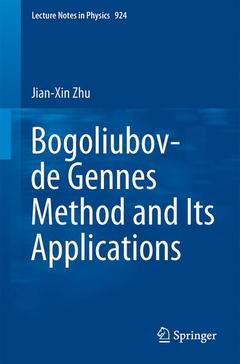Bogoliubov-de Gennes Method and Its Applications, 1st ed. 2016 Lecture Notes in Physics Series, Vol. 924
Auteur : Zhu Jian-Xin

The purpose of this book is to provide an elementary yet systematic description of the Bogoliubov-de Gennes (BdG) equations, their unique symmetry properties and their relation to Green?s function theory. Specifically, it introduces readers to the supercell technique for the solutions of the BdG equations, as well as other related techniques for more rapidly solving the equations in practical applications.
The BdG equations are derived from a microscopic model Hamiltonian with an effective pairing interaction and fully capture the local electronic structure through self-consistent solutions via exact diagonalization. This approach has been successfully generalized to study many aspects of conventional and unconventional superconductors with inhomogeneities ? including defects, disorder or the presence of a magnetic field ? and becomes an even more attractive choice when the first-principles information of a typical superconductor is incorporated via the construction of a low-energy tight-binding model. Further, the lattice BdG approach is essential when theoretical results for local electronic states around such defects are compared with the scanning tunneling microscopy measurements.Altogether, these lectures provide a timely primer for graduate students and non-specialist researchers, while also offering a useful reference guide for experts in the field.
Dr Jian-Xin Zhu obtained his PhD from the University of Hong Kong in 1997. He is presently a staff member of the Theoretical Division, Los Alamos National Laboratory, and also a Partner Science Leader in the thrust of Theory and Simulation of Nanoscale Phenomena of the Center for Integrated Nanotechnologies (CINT), a U.S. DOE BES user facility. Dr Zhu, who was awarded the LANL Postdoctoral Distinguished Performance Award in 2003, is an internationally known expert on the theory of superconductivity and on electronic structure in strongly correlated systems, with a particular focus on the theoretical analysis of scanning tunneling microscopy and photoemission spectroscopy measurements.
Date de parution : 06-2016
Ouvrage de 188 p.
15.5x23.5 cm
Mots-clés :
Andreev Reflection Process; Blonder-Tinkham-Klapwijk Theory; Distribution of Nonmagnetic Impurities; Green’s Function Method; High-Tc Cuprates; Kondo Coherence Order Parameter; Kondo Hole System; Majorana Fermions; Mesoscopic Superconductivity; Multi-Orbital SuperConductors; S-wave Superconductors; Topological Kondo Insulator; Topological Superconductor; Transport Across Superconductor Junctions; Vortices in Superconductors; d-wave Superconductors



